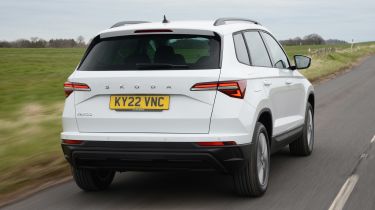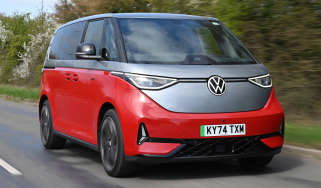Skoda Karoq - Engines, performance and drive
There are sportier SUVs, but the Skoda Karoq strikes a pleasing balance between comfort and driving fun

Under the skin, the Skoda Karoq uses a tried-and-tested recipe, combining the VW Group’s MQB underpinnings (with MacPherson strut front suspension and a torsion beam rear axle on 2WD versions, while 4x4 cars have a multilink set-up) that also forms the basis of the Kodiaq and many other models in the Czech brand’s line-up, highlighting its versatility.
On the move, the Skoda feels sharper than the Peugeot 3008. The steering is nicely weighted and more responsive – helping the car feel more agile, with less roll when changing direction. This stems from the Karoq’s firmer suspension, but the downside is that you’ll feel more body and wheel movements than in the 3008, which smooths out poor surfaces nicely. The Karoq isn't as firm as its SEAT Ateca sister model, and our group test showed that it rides better overall than the Vauxhall Grandland and Nissan Qashqai.
The faster you go, the more the Karoq’s fine body control comes to the fore, giving plenty of security and confidence. The slick-shifting manual gearbox is fun to use, and the well-shaped steering wheel feels good in your hands.
The more energy you put through the springs and dampers, the more the ride quality calms down, but because SUVs are likely to spend lots of time in town, the firmness from the Skoda’s suspension over broken surfaces just takes the edge off the car’s otherwise impressive refinement score.
Used - available now

2022 Skoda
Karoq
15,114 milesManualPetrol1.5L
Cash £19,583
2020 Skoda
Karoq
41,651 milesManualDiesel2.0L
Cash £15,600
2023 Skoda
Karoq
22,089 milesManualDiesel2.0L
Cash £19,100
2022 Skoda
Karoq
18,550 milesManualPetrol1.5L
Cash £14,499The Sportline model comes with 19-inch alloy wheels, which we feel unduly affects the Karoq's ride - causing a fairly compliant mid-size SUV to develop unwelcome jiggliness over uneven A and B roads. Some annoying harmonics also presented themselves over concrete sections of motorway. We would recommend models with smaller wheels for this reason (our prefered SE L has 18-inch items). The Karoq is also marred by a little wind noise around the windscreen pillars and door mirrors at higher speeds.
0-62mph acceleration and top speed
Of the three petrol engines, the mid-range 1.5 TSI comes out as our clear favourite, although the smaller 1.0-litre three-cylinder engine performs pretty well, too. The entry-level TSI unit makes a respectable 114bhp, and while it will accelerate the Karoq from 0-62mph in 10.3 seconds, it’ll feel a little strained at higher speeds when fully laden. If you work it hard, the engine - which delivers a not unpleasant three-cylinder thrum - does cause a small amount of vibration through the pedals.
The 148bhp 1.5 TSI has a broader power band, making it a stronger performer. It’ll get from 0 to 62mph in 8.9 seconds (or 9.0 seconds with the DSG twin-clutch auto option), and you don’t have to work the engine quite so hard to get up to motorway speeds.
The 2.0-litre TSI petrol is available in Sportline trim with the seven-speed DSG dual-clutch gearbox and all-wheel drive. Its 187bhp output makes the Karoq decidedly lively, and it can accelerate from 0 to 62 mph in 7.0 seconds.
The 2.0-litre TDI has 148bhp, and knocks off the benchmark sprint in 8.7 seconds, as well as offering enough punch for overtaking. This will help if you intend to tow a caravan with your Karoq, as will the fact that this engine can also be accompanied by all-wheel drive.












